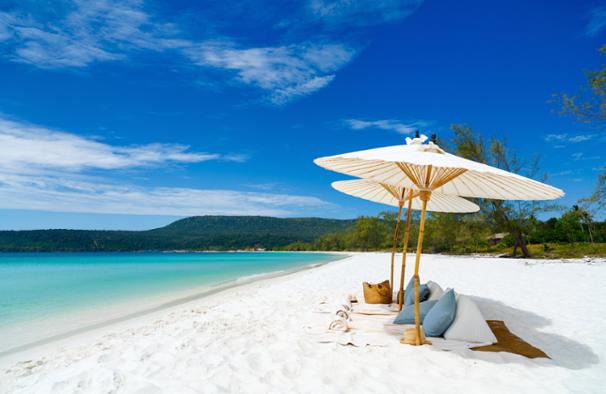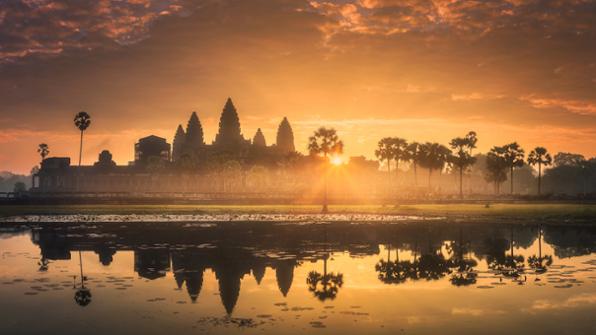
The benefits of the low and high seasons
Traveling to Cambodia may raise numerous questions regarding the best time to visit: Should you go during the high season or the low season? Sun, heat, or rain and floods? The decision is not as simple as it may seem, and various preconceived notions can influence your choice. Let’s clarify things and dispel some of the common misconceptions by focusing on the advantages of visiting Cambodia during both seasons.
The alternating flow of the Tonlé Sap River in Cambodia governs a necessary and inevitable cycle: the changing of seasons. From May to November, during the monsoon season, the river flows from south to north, emptying into and filling its namesake lake. From November to May, during the dry season, the natural reservoir releases its waters, reversing its current, flowing back toward the Mekong River, eventually reaching Phnom Penh. This process brings about a semiannual shift in the kingdom's climate. It is easy to assume that the dry season is marked by relentless sun and scorching heat for six months, while the rainy season means flooding and an almost impossible challenge to step outside due to daily downpours. However, this is not entirely accurate. Both seasons have their advantages for travelers to Cambodia.
If you enjoy rain…
Leaving the cold winter of France behind to land in the scorching heat of Southeast Asia is sure to whet your appetite for adventure. Escaping the oppressive summer heat of Europe for the refreshing monsoon rains of Cambodia might also appeal to some, if not for the negative imagery that often accompanies the phrase "rainy season." In this context, "rainy season" may evoke images of deluges, floods, and wading home in the water. While this can occasionally be true, it is not the whole story. From May to November, the rains intensify but do not occur daily. On average, showers last only one or two hours and, although they may cause occasional flooding, the country is well-prepared. Cambodians have lived through these periods for centuries. For instance, in rural areas, elevated roads allow for travel even when it is pouring. You’ll also notice that nearly all homes are built on stilts. These elevated homes provide an ideal spot to watch the rain and wait for it to pass. If your trip is well-planned and anticipated, the rainy season can become a truly unique experience. The landscapes and vegetation are magnified by the natural rainfall.

(How about a little boat ride?)
The Tonlé Sap Lake sees its surface area expand from 2,700 to 16,000 square kilometers during the rainy season. This increase in water surface allows for adventurous travelers to travel from Siem Reap to Battambang by boat. This form of travel can be a fantastic way to enjoy the fresh air and coolness of this natural reservoir. Beyond the surprise and beauty of what one can see during the rainy season, a more practical reason to visit Cambodia between May and November is the cost savings. You can save up to 20% on your trip—flights and hotels—during the monsoon season. Additionally, visiting during the low tourist season guarantees fewer crowds at cultural or heritage sites, allowing you to enjoy a more relaxed experience. You’ll also have access to the best French-speaking guides and drivers, ensuring that you receive special attention at attractions and activities.
A warm, sunny winter
As mentioned earlier, the allure of the sun and warmth is undeniable, especially when escaping Europe’s icy winters. For those who prefer the beach to the mountains, Cambodia offers beautiful coastal areas, particularly during the dry season. From December to April, the sun graces the Cambodian sky, and its brilliance is sure to captivate you, even if you take a few moments to rest and soak in the sun’s splendor.

(Beach of Koh Rong Island)
The islands of Koh Rong and Koh Rong Samloem, off the coast of Sihanoukville, are prime examples of paradise. Their idyllic beaches and untouched jungles are perfect for a visit during the dry season. As night falls, the bioluminescent plankton light up the shores in a turquoise glow, adding to the magical atmosphere. The discovery of local traditions, architecture, and cultural heritage during the dry season also has its undeniable advantages. The accessibility of sites is made easier by the favorable weather, making visits to places like Angkor Wat even more enjoyable. For example, you can be sure to witness the breathtaking sunrise from the top of the central tower of Angkor Wat, an experience not to be missed.

(Meet at 5 a.m. at Angkor Wat to admire the natural phenomenon.)
Though the sun rarely disappears from Cambodia’s skies during the dry season, the temperatures are not overwhelmingly hot. December and January bring cooler nights, with temperatures dropping to around 15°C (59°F), offering a pleasant respite for a restful night’s sleep after a day full of enriching activities.
Thibault Bourru